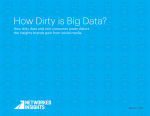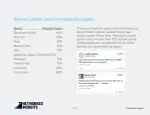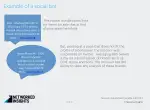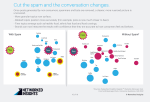It’s no secret that huge brands use Twitter as the world’s biggest focus group. Companies keep their ears pressed up against the wall via social media, determined to suss out what their customers think of them. It’s also no secret that social media data is full of “noise”–messy, useless, irrelevant data. Now, a new study finds that much of that “noise” is generated by links to coupon sites and celebrity retweets.
Networked Insights, a Chicago-based analytics firm, recently released a report claiming many of the world’s best-known brands are primarily mentioned on Twitter, Facebook, and other social media platforms in the form of spam, coupons, or adult content–essentially, their brands are hijacked to lure unsuspecting users to click through to unrelated material. According to Networked Insights’ research, 95% of the mentions of Rite Aid on social media are spam messages, as are mentions of Elizabeth Arden. Visa has an impressive 81% spam rate, as does rival MasterCard, with 76%. Seventy percent of mentions of Fisher-Price toys on social media are spam, while 68% of the mentions of cosmetics firm Lancome have nothing to do with consumers actually discussing the cosmetics. (While Networked Insights didn’t confirm whether these companies were clients, a scan of the brands’ social streams via Twitter and Topsy seemed to back up the frequency of spam in each case.)

Jaime Brugueras, Networked Insights’ vice president of analytics, explained that his organization finds three different kinds of noisy social media posts (which they referred to as “undesirable”) when analyzing Twitter, Facebook, and other platforms. There’s either the active coupon/deal trading subculture spurred by RetailMeNot, FatWallet, and similar sites; celebrity brand tweets (which may momentarily elevate the visibility of a company but don’t reflect its broader customer base); and spam for products, services, or adult content that leverages the hashtags or accounts of popular brands in order to reach as large an audience as possible.
According to Networked Insights, coupons and coupon-related posts make up 5.8% of all brand discussion on social media, adult content is responsible for 2.2%, and general spam is another 1.3%. These three types of posts are found most often on web forums (where they collectively make up 28.8% of posts), blogs, and comments (where spam is 19.6% of content), and on Twitter (which is, as of fall 2014, 9.3% spam). The number is so high on web forums, the authors of the study say, because they tend to have more advertisements and solicitations than other forums.
One of the problems marketers and companies like Networked Analytics face is the fact that spammers are getting better and better. “Spambots are getting more sophisticated,” Networked Insights’ vice president of strategic sales Brian Johnson said. “Some of these accounts are very difficult; in some cases it’s hard to see if its a legitimate profile or not. Oftentimes, you have to read through the tweets a number of times to see if it’s a person or if it’s something that was just made to very closely imitate a human. I went to a Twitter handle recently and went through 40-50 tweets that were all scripture quotations before I found a link trying to sell some schlock. They can trick computers into thinking it is all perfectly legit content.”
And for brands that use Twitter and Facebook to monitor consumer sentiment, that means trouble. Spambots pushing dubious fake Viagra pills or coupon clippers trading discount codes for free shipping create headaches for companies trying to understand what beer goes with Domino’s Pizza, or what store mall patrons visited before hitting up Hollister. As the graphic above shows, removing spam from the equation changed the results customers saw considerably. “We didn’t necessarily seek to understand why spam exists,” Johnson told me, “but we wanted it out of the system.”
While spam makes for difficulties accurately reading consumer sentiment, in some ways it means brands are on the right track. Spam and adbots might be frustrating, but the hashtags brands use are designed to catch as many eyeballs as possible. In a twisted way, being spamjacked just means a brand is doing their job of being ubiquitous.
Recognize your brand’s excellence by applying to this year’s Brands That Matter Awards before the early-rate deadline, May 3.






